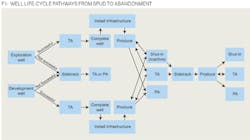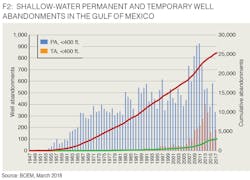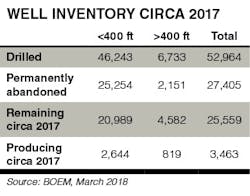Well abandonment rates in shallow-water Gulf of Mexico off historic highs
Mark J. Kaiser,Center for Energy Studies, LSU
Inthe thirdpart of this series on Gulf of Mexico well activity, the focus is on abandonments. Circa 2017, 52,964 wells have been drilled in the Gulf of Mexico and 27,405 wells have been permanently abandoned, about half of all wells drilled. Remaining well inventories at the end of 2017 totaled 25,559.
Permanently abandoned (PA) wells represent the final state of a wellbore, while temporarily abandoned (TA) wellsrepresent a transitory state for wells on their way to production or permanent abandonment.
Pathways
There are many different pathways wells follow during their lifetime depending on why they were drilled, where they were drilled, how they were drilled, and whether the well was a keeper (successful) or not.
After wells are drilled they are temporarily abandoned before structures are installed to protect the wellbore or subsea equipment is ready to handle production. Producing wells that cease production for a long period for time are temporarily abandoned if operators expect to use them in the future (e.g., side tracked) or if they are waiting to be permanently abandoned. Permanent abandonment is the final state of all wells.
Wells may switch status between production and temporary abandonment one or more times during its lifetime, and whenever a side track is drilled it will create a new well and forward path.
Abandonment class
Wells that have not produced for many years are required to be placed in TA status with producing formations plugged with cement barriers and a bridge plug near the mudline. TA wells may remain inactive for many years, but all TA wells will eventually be classified as permanently abandoned after final operations are performed and conductors/risers are cut and removed.
Under exceptional circumstances (e.g., hurricane destruction) TA wells may be considered the final status of a wellbore.
Permanent abandonment activity and PA wells are unambiguous in the sense that their status denotes the end state of the well and once entered will not lead to another state (unless found to be leaking in which case the well will be reclassified as TA during remediation operations). TA activity and TA status wells are more elusive because of their different objectives and transitory nature.
Temporarily abandoned wells are neither producing nor permanently abandoned but are on their way to one of these states. Whereas PA inventory can only increase with time, TA inventories can increase or decrease as status codes change and new stock added.
Activity
In water depth <400 ft (122 m), there were 25,254 PA wells out of 46,243 wells drilled in the region, leaving 20,989 wells remaining to be permanently abandoned circa 2017.
In water depth >400 ft, there were 2,151 PA wells out of 6,733 wells spud, leaving a well inventory of 4,582 deepwater wells remaining to be plugged circa 2017.
In shallow water, plug and abandonment activity began soon after the first wells were drilled in the region, either because they were not successful or because of production cessation. By the mid-1960s abandonment activity reached 300 permanent abandonments per year and has stayed above this level ever since.
In later years larger numbers of well abandonments coincided with higher structure decommissioning activity, reaching 500 permanent abandonments in 1983 and 900 permanently abandoned wells in 2009 and 2010, historic highs.
Before structures are decommissioned, all wells associated with the structure must be permanently abandoned, and thus one would expect a correlation between PA activity and structure decommissioning.
In deepwater, PA activity is on a much smaller scale because well inventories are much smaller, younger, and potentially more valuable until fields are exhausted. TA activity in deepwater is higher on a relative basis because of development requirements and option value.
Circa 2017, about 25% of deepwater abandonments activity are TA wells (566/2,151), compared to about 12% (3,063/25,254) in shallow water. •




